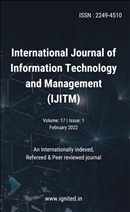Employee Motivation
Main Article Content
Authors
Abstract
Now a days employee motivation is very important for the development of the organization andto achieve goals. Previously we used to think that only money can motivate. But after researching we foundit that not only money but also other things also play a vital role.e.g- good relationships among themselves and upper authority, friendly and healthy environment, fringebenefits, oppourtunity of getting free schooling and medical benefits etc.Employee Motivation will help the employees to stick with the organization and love for the organization,which will automatically give profits to the organization and there will be less absentism, less frustration,which will help both employer and employees to build their career.Before we used to think that motivation is only done by incentives. But later many experts ofmanagement told that with incentives, mental satisfaction, friendly environment is also needed. Manyorganizations motivates the employee by giving e.g. – schooling facilities for their kids, medical benefitsetc. Human relation and human behaviour is also linked with Employee Motivation.
Downloads
Download data is not yet available.
Article Details
Section
Articles
References
- Cascio, W. F.,(1998) Managing Human Resources, Irwin/McGraw Hill, 5th Edition. Dadabhoy, B.K(2013). Barons of Banking : Glimpses of Indian Banking history. Random House.
- Desai, Vasant (2005). Indian Financial System. pp 481 Himalaya Publishing House. Gill, J.,Johnson, P., (2010). Research methods of managers, sagc publication limited, fourth edition.
- Gupta C.B. (2007). Human resource Management. Sultan chand and sons, New Delhi, PP.12.3.12.4.
- Gupta C.B. (2004). Human resource Management, 1st Edition, sultan chand& sons New Delhi.
- Gupta K.C. (1997). Human resource Development in Banking sector current trends in human resource Development, (edited by singh, B. and Kumar, P.) Deep and Deep Publications, New Delhi, pp 322-330.
- Jain, V.k., (2000). New Trends in human resource Management, RBSA publishers, Jaipur, India PP-1-11.
- Jain, V.k., (1996).HRD practices in Indian Industries. Anmol Publications Pvt. Ltd. New Delhi.
- John P.W. (2005). Human Resource Development 2nd edition. Leaving and training for individuals and organization, kogan page, New Delhi, India PP-3-11.
- Mathur, B.L.(1990). Huan Resource Development. Aritiant Publishers. Jaipur. Megginson, L.C., (1982). Personnel and human resource administration. Homewood III: Richard D. Irwin, P.6.
- Mekenna, E(200). Business Psychology and Organizational Behavior, (3rd edition), Philadelphia psychological press.
- Michael, V.P.(1995). HRM and Human Relations. Himalaya Publishing house, New Delhi, PP, 155,5.
- Module,(2009). Career planning and development. McGraw hill.
- Aggarwal, N., Kapoor, M, (2012) Human Resource information systems (HRIS) – Its role and importance in the business competiveness. Gianjyoti E-Journal, vol, 1, issue 2.
- Alphonsa, V.K.(2000). HRD climate in a private Hospital in Hyderabad: An Empirical study, IJTD, Vol XXX, NO.4.
- Anil K., (2007). Moving HRD from the periphery to the center for transformation of an Indian Public sector Bank, Human Resource Development International, Vol. 10, No. 2, pp 203-213.
- Ankita Jain, Anukool Manish Hyde. A REVIEW OF HUMAN RESOURCEMANAGEMENT IN SELECTED BANKS IN INDIA. International Education &research Journal[IERJ]. E-ISSN No.: 2454-9916|Volume :4|Issue : 10| Oct 2018, 36-37
- Anubha, R.,(2011). Counselling : A key tool for today’s managers. International journal of enterprise computing & business systems, Vol-1, Issue 2, July (2011).
- Arhaf .S.H., (Oct 2003-June 2004). Human Resource Development in tourism Industry, A Quarterly journal ogf management PRABANDH, JawaharBhawan, Lucknow,pp 14-22.
- AvinashSingh . Review of literature on HR Practices in India Banking Sector. IJRAR – International Journal of Research and Analytical Review.6(2). 2019, 54x-61x.
- Ballabh, J.(2001). The Indian Banking industry: Challenges ahead. IBA Bulletin XXIII(4&5), 8-10.
- Baqual, G.M.(2005). Human Resource Development practices in colleges. The business peep, vol.1, No. 1, pp74-78.
- Benjamin. A. & David I., (2012). HRD climate and employee commitment in RecapatalizedNigerion Banks, International journal of Business Management , vol. 7, No.5.
- Bharathi. N. (2007) Indian Banking & finance – A Paractigm shift.
- Bhatia, A.K. 2(2014). Global training & Development trends &practices: An overview. International journal of emerging reseach in management & technology, Vol 3, issue 8.
- Sanjeeb Kumar Dey, Dinesh Kumar Sahu. HRM Practices in Indian Banking Sector: A Comparative study of Public and Private sector Bank in Odisha. International Journal for Research in Engineering Application &Management (IJREAM).ISSN : 2454-9150 Vol-04, Issue-05, Aug 2018.
- KalakotlaSuman, Human Resource Management & practices in Indian Banks. International Journal of Academic Research. ISSN: 2348-7666; Issue-2(1), February, 2017
- Kour, Dr. Harjeet&Gakhar, Kamlesh.(2015). Innovative HRM Practices: A comparison of Public and Private Sector Banks in India. MANTHAN : Journal of Commerce and Management. 2.10.17492/manthan.v2il.6432.
- Nidhi. HRM in Indian banks : Past, present and future. International Journal of Multidisciplinary Reseach and Development 2014; 1(1): 99-112.
- Revati Ram RaoRautrao. D.Y. PatilVidyapeeth`S. A study of Green HRM& its Evaluation with existing HR practices in Banking System. International Journal of Disaster Recovery and Business Continuity Vol.11, No. 1, (2020), pp. 1100-1108
- Wang, G.D. (2002). A system approach to measuring returns on investment for HRD program. Human Resources Development Quarterly, 13(2), pp 203-224. Woodall, j. (2004). HRD: philosophy values and practice. Human Resource Development international, 7(2), 147-149.
- Nonaka, I.(1994) A Dynamic theory of organizational knowledge creation. Organization Science 5:1, 14-35.

